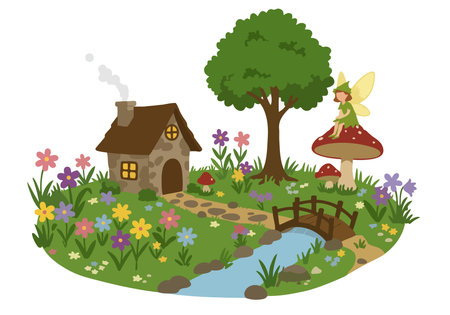Introduction to Wildlife Encounters in the UK
The United Kingdom, with its patchwork of ancient woodlands, rolling hills, rugged coastlines, and tranquil lakes, offers a truly special setting for wildlife encounters. From the Scottish Highlands to the Cornish cliffs, British landscapes are home to a remarkable array of native species. For families seeking outdoor adventures, camping is not just a way to escape urban life—it’s an invitation to explore nature’s classroom. Children and their pets can experience the thrill of spotting red squirrels in a forest glade, listening for owls at dusk, or watching otters play along a riverbank. The UK’s commitment to conservation and public access means that safe, educational experiences abound, whether you’re pitching a tent in a national park or joining a local wildlife walk. In this article series, we will delve into the unique opportunities that British nature provides for family camping trips—always with an eye on safety and respect for local habitats—ensuring unforgettable memories for both young explorers and their four-legged friends.
2. Preparing for Your Camping Adventure
Setting out on a wildlife camping trip in the UK is an exciting opportunity for families and their pets, but careful preparation is key to making sure everyone has a memorable and safe experience. Choosing the right pet-friendly campsite is your first step. Not all sites welcome animals or cater for children’s needs, so it’s wise to research in advance. Look for campsites that advertise dog-friendly facilities, secure boundaries, and access to nature trails suitable for young explorers and four-legged friends alike.
Essential Criteria for Pet-Friendly Campsites
| Criteria | Why It Matters | What to Look For |
|---|---|---|
| Pet Policies | To avoid disappointment on arrival and ensure compliance with site rules | No breed restrictions, lead requirements, designated dog-walking areas |
| Child Safety Features | Ensures peace of mind and safe play for youngsters amidst British wildlife | Fenced play zones, proximity to water sources, supervision guidelines |
| Wildlife Awareness | Keeps both pets and kids safe from unexpected encounters with native species | Information boards, staff advice on local fauna, guidance on responsible behaviour |
| Amenities & Facilities | Makes stays comfortable for all family members – two- and four-legged! | Poo bins, water taps, shaded pitches, communal fire pits (if allowed) |
Packing Essentials: Children and Pets Edition
When packing, aim for a balance between comfort, practicality, and respect for British wildlife. For children, pack weather-appropriate clothing—think wellies for muddy trails and waterproofs for sudden rain showers—plus torches or headlamps for evening explorations. Don’t forget first-aid kits tailored to both kids and pets, including tick removers as ticks are common in many UK wild spaces. For pets, bring leads, biodegradable poo bags, familiar bedding to ease anxiety, and enough food and water bowls.
Checklist for a Safe Stay Amongst British Wildlife:
- ID tags: Ensure pets wear up-to-date ID tags at all times.
- Recall training: Practise recall commands before your trip to help manage your dog around wildlife.
- Wildlife briefing: Teach children basic rules: never approach wild animals, keep noise down at dawn/dusk, and always stay within sight of adults.
- Litter-free policy: Instruct kids and supervise pets to avoid leaving food scraps that could attract unwanted visitors like foxes or badgers.
- Campsite etiquette: Respect quiet hours and leash laws—these are especially important where ground-nesting birds or protected mammals are present.
Your First Step: A Shared Adventure Begins with Good Prep
A successful British camping adventure starts long before you pitch your tent. By selecting the right campsite and preparing thoughtfully for both children’s curiosity and pets’ instincts, you’ll create a positive environment where everyone can safely enjoy close encounters with the UK’s remarkable wildlife.
![]()
3. Wildlife Watching: What to Spot and Where
For families and pet owners keen on wildlife encounters during camping trips, the UK offers a remarkable diversity of species and habitats. Knowing what to look for – and where – is key to making your nature adventure both exciting and educational.
Common and Iconic Species in the UK
Hedgehogs
The humble hedgehog is a beloved symbol of British wildlife, often found in woodland edges, meadows, and even campsite hedgerows. Early mornings or dusk are the best times for quiet observation. Teach children to keep a respectful distance and watch as these nocturnal creatures snuffle through the undergrowth.
Red Squirrels
Spotting a native red squirrel is a real treat, especially since they have become rarer in much of England. Head to reserves in Northumberland, Cumbria, or parts of Scotland for your best chance. Encourage kids to look up—these agile animals dart between branches, searching for nuts and seeds.
Native Birds
The UK’s birdlife is rich and varied. Keep binoculars handy for glimpses of robins flitting near picnic tables, majestic red kites circling above Welsh valleys, or puffins along coastal cliffs in summer. Bird-watching can be especially rewarding for young campers learning patience and observation skills.
Prime Locations for Nature Encounters
Woodland Campsites
Forests such as the New Forest or Sherwood Forest offer safe spaces for children and pets to explore while providing excellent opportunities to spot deer, foxes, and woodland birds.
Lakes and Wetlands
The Lake District and Norfolk Broads are havens for waterfowl, otters, and dragonflies. Boardwalk trails make wildlife watching accessible even with little ones or dogs in tow.
Coastal Adventures
Cornwall’s coastal paths or Scotland’s Moray Firth provide sightings of seals basking on rocks and occasional dolphins offshore—making seaside camping both scenic and wild.
With a bit of planning, your camping trip can be transformed into an unforgettable wildlife safari that inspires curiosity and respect for nature in every member of the family—including four-legged companions.
4. Nature Education for Kids
When it comes to camping in the British countryside, nature education for children is a golden opportunity to foster lifelong curiosity and respect for the environment. By engaging in hands-on activities, kids not only learn about local wildlife but also develop practical skills and an appreciation for the natural world that surrounds them.
Fun and Insightful Activities
One of the most effective ways to engage children is through fun and practical experiences. For example, guided bug hunts and birdwatching sessions can be both entertaining and educational. Children can use simple identification guides to spot native species such as robins, hedgehogs, or even the elusive red squirrel. These activities encourage observation, patience, and teamwork.
Learning Opportunities Through Exploration
Exploring local flora and fauna allows children to connect with Britain’s rich biodiversity. Setting up a mini nature trail or a scavenger hunt can help them discover different plants, trees, and small creatures in a safe and supervised way. These adventures not only teach kids about ecology but also instil a sense of responsibility towards protecting natural habitats.
Sample Activity Table: Connecting Kids with Nature
| Activity | Description | Key Skills Developed |
|---|---|---|
| Leaf Identification Walk | Children collect leaves from various trees and use a guide to identify each species. | Observation, Research, Environmental Awareness |
| Pond Dipping | Using nets, kids explore pond life, identifying insects and amphibians found locally. | Scientific Inquiry, Patience, Respect for Wildlife |
| Nest Building Challenge | Teams create ‘nests’ using natural materials found nearby, learning about bird habitats. | Creativity, Teamwork, Problem-Solving |
| Nightingale Storytime | A quiet evening session sharing stories about British woodland animals around the campfire. | Listening Skills, Imagination, Cultural Heritage |
By immersing themselves in these carefully designed activities, children gain insights into Britain’s unique ecosystems while creating lasting memories. With a blend of structured learning and free exploration, camping becomes more than just an outdoor escape—it transforms into a living classroom where every leaf and creature tells a story worth discovering.
5. Keeping Pets Safe and Happy in the Outdoors
When heading into the great British countryside with your family and beloved pets, it’s crucial to ensure their safety, comfort, and positive engagement with nature. A well-prepared approach not only protects your furry companions but also helps preserve the local wildlife you’re there to appreciate.
Best Practices for Outdoor Pet Care
Firstly, always keep your pets within sight and under control, especially around sensitive habitats. The use of leads or harnesses is highly recommended when walking dogs in areas where livestock or ground-nesting birds may be present. This practice aligns with the Countryside Code and reduces the risk of disturbing wildlife or encountering unforeseen hazards such as busy pathways or waterways.
Essential Equipment Recommendations
- Leads and Harnesses: Opt for adjustable leads that give your pet some freedom while still keeping them secure. Reflective materials are ideal for low-light conditions often found in British woodlands.
- Portable Water Bowls: Hydration is key, particularly during warm spells or after energetic activities. Collapsible bowls are lightweight and easy to pack.
- Paw Protection: Consider dog boots if you’ll be traversing rough terrain; they protect against sharp stones, thorns, and even salt on winter paths.
- Tick and Flea Prevention: Use up-to-date preventative treatments as rural areas can harbour ticks and fleas, which pose health risks to both pets and humans.
Respecting Wildlife While Camping
Your pets are naturally curious, but teaching them to observe wildlife from a distance is vital. Not only does this help protect nesting birds, hedgehogs, or deer, but it also models respectful behaviour for children. Reinforce recall commands with treats or praise to reward calm observation rather than chasing or barking at animals.
Integrating Pets into Family Nature Experiences
Involve your pets in age-appropriate educational activities such as scavenger hunts (with safe items), gentle trails, or scent games that encourage natural exploration without disrupting the environment. Sharing these experiences strengthens family bonds and helps children learn responsibility towards animals and nature alike.
By following these best practices and using reliable equipment, families can ensure that their outdoor adventures are enjoyable for everyone—humans and pets included—while safeguarding Britain’s cherished wildlife for future explorers.
6. Responsible Camping and Conservation
When introducing children and pets to the wonders of wildlife through camping in the UK, it’s crucial to model and instil responsible behaviour. The British countryside is a patchwork of habitats, ancient woodlands, meadows, and protected reserves—each requiring respect and careful stewardship from visitors. To minimise our ecological footprint, always follow the official Countryside Code: leave gates as you find them, stick to marked paths to avoid trampling delicate flora, and take all litter home, even biodegradable waste.
UK Guidelines for Minimising Impact
Wild camping and family-friendly sites often operate under strict local regulations. Use designated fire pits if fires are allowed, never pick wildflowers or disturb nests, and keep pets on leads near livestock or during bird nesting season. Portable toilets or digging a small latrine far from water sources helps protect streams and rivers from contamination. Teach youngsters about the importance of these rules by involving them in daily campsite checks and cleanup routines.
Adhering to Countryside Codes
Respect for landowners and fellow campers is vital. Many areas in the UK are working farmland or conservation zones. Always seek permission before pitching tents on private land and heed signage regarding restricted areas or wildlife protection efforts. Quiet hours should be observed at dusk to avoid disturbing nocturnal animals—a perfect opportunity to listen quietly for owls or hedgehogs with your children.
Fostering Respect for Nature in Young People
The best way to cultivate a lifelong respect for nature is through hands-on learning. Encourage kids to observe wildlife from a distance using binoculars instead of chasing after animals. Provide them with identification guides for local birds, insects, or plants, turning each walk into an educational treasure hunt. With pets, demonstrate how they can enjoy new scents and sounds without causing harm—rewarding calm behaviour around wildlife reinforces positive habits. In doing so, we help the next generation become conscientious guardians of Britain’s natural heritage.

